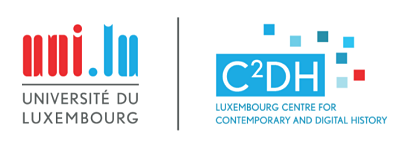The Luxembourg Center for Contemporary and Digital History (C²DH) at the University of Luxembourg organised the 4th RESAW Conference online. With the support of the FNR (Luxembourg National Research Fund; RESCOM/2020/15002969) the conference took place on June 17-18 , 2021. The main topic was related to “Mainstream vs. Marginal Content in Web History and Web Archives”. The Conference was preceded by pre-workshops on June 14 and was part of a Web Archiving week with the IIPC General Assembly and Web Archiving Conference hosted online by the National Library of Luxembourg (BNL) on June 15-16, 2021.
Researchers, web archivists, curators, computer scientists, information specialists, and the representatives of all the multidisciplinary areas involved in the topic had the opportunity to discuss for an entire week the evolution and challenges of web history and web archives, as well as best practices in analyzing archives, archiving Covid-19, supporting research use of the web, capturing and unlocking Social Media, national web domains, among many of the topics covered during the two events.
During the 4th RESAW Conference, the “engaged community” spirit inherent to the Research Infrastructure for the Study of Web Archived Materials was once again one of the main recipes for success, as its coordinator, Niels Brügger, Head of NetLab and the Centre for Internet Studies, at Aarhus University highlighted during the opening of the event.
Andreas Fickers, Head of C²DH at the University of Luxembourg and the event organisers, Valérie Schafer, Professor in Contemporary European History at the University in Luxembourg and Frédéric Clavert, Senior Research Scientist at the University of Luxembourg, were also in charge of the opening remarks (read the opening remarks by Frédéric Clavert). The presenters focused on the importance of “Mainstream vs. Marginal” and emphasized how this dichotomy has dominated the web since its creation. At the same time, all of them agreed on the importance of archiving marginal content for web history, despite its challenges – not without forgetting either about the difficulties of archiving the mainstream due to the massive volume of data and some access restrictions (for example on Facebook).
17 June: An intense full day of work and exchanges focused on virality, audience, participation
The Conference started with a roundtable on Online Virality, organized by the HIVI project, led by Valérie Schafer at the Luxembourg Centre for Contemporary and Digital History (C²DH), University of Luxembourg, and supported by the Luxembourg National Research Fund (2021-2024).
The speakers Pierre-Carl Langlais, Université Paul-Valéry Montpellier III; Frédéric Clavert, University of Luxembourg; Ditte Laursen, The Royal Danish Library; Tuğçe Oklay, University Paris 8 Vincennes – Saint-Denis; Surbhi Tandon, Guru Gobind Singh Indraprastha University; and Durgesh Tripathi, GGS Indraprastha University presented their views on why to study Memes, why virality matters, who participates, where and when content become viral and how society is trying to express itself via memes, among others. This led to a fruitful discussion on challenges in preserving virality in web archives, techniques and methods to study historical virality, how to research virality and dissemination and explore virality and controversies in Twitter (see for example the presentation by Ditte Laursen). They also highlighted the importance of understanding the questions of power and ideology behind political memes and discerning the “hero” and the “victim”, the stakeholders, how organizations and Generation Z and Millennials are using Memes.
During both days, the audience had the chance to select between parallel sessions with an international variety of case studies delving into RESAW’s Conferences multidisciplinary essence (for example, “Nominating, awarding,” or “Commenting, Propagating and Participating,” during the first day).
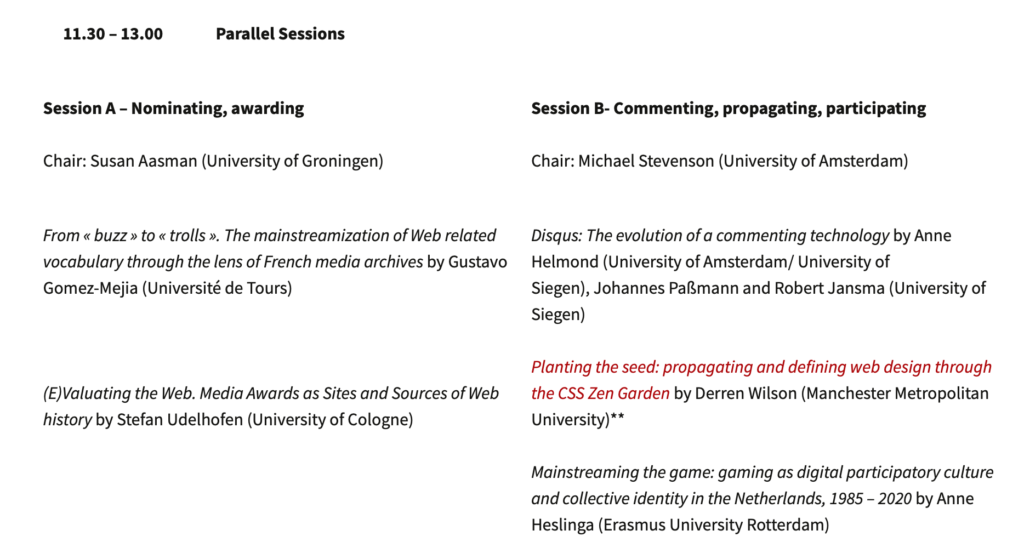
During the “Fading Stars” session, chaired by Gerard Alberts (University of Amsterdam) the audience had the opportunity to dive deeper into Usenet history and explore the sci environment case thanks to Giorgos Zoukas (National and Kapodistrian University of Athens). They also had the chance to take a journey through MyKnet.org and understand the rise and fall of the indigenous web-based platform in Northwestern Ontario, Canada, with Philipp Budka (University of Vienna). In addition, Frances Corry, from the University of Southern California, presented her research focused on data loss in MySpace during a server migration in 2019, while exploring the different employees’ attitudes towards this episode.
The first day of the Conference continued with plenty of vivid discussions on Panel Measures from the Margins of the Early Web, chaired by Meg Leta Jones, from Georgetown University with presentations like “Fighting For ‘A Home of Our Own’: TheTransgender Community Forum in Web History,” by Avery Dame-Griff (Appalachian State University); “A browser on every desktop: Microsoft and the mainstream of the web,” by Kevin Driscoll (University of Virginia), and “Hits, Links, and Counters: Networking Popularity on the Early Web,” by Megan Sapnar Ankerson (University of Michigan).
The keynote speaker of the day, Clarisse Bardiot (Université de Valenciennes et du Hainaut-Cambrésis) presented “Theatre analytics: the performing arts, the ephemeral, its traces, and the web.” She outlined the main challenges and opportunities of online digital traces for the study of the performing arts and presented some software applications (MemoRekall and Rekall) she developed to analyze them. During her presentation, she insisted on the importance of preserving performances by documenting them to make “the implicit explicit.” According to Clarisse Bardiot, artists are currently the best archivists of their work. They are becoming increasingly aware of the importance of the preservation and challenges of the digital environment since they faced many losses from their work from the 1990s and at the beginning of the century. However, they are still at an early stage, and as she mentioned, there is still plenty of work to do (watch the keynote).
After an intense day of discussions and exchanges, the RESAW Party, organised by the HIVI project, was full of virtual challenges to chill out. First, they faced an individual Memes quiz to demonstrate their Meme savvy, and they participated in two creative group activities. In the first part, they had to name their group after a software of the 1990s, and in the second part, they had to create a Meme showing their emotion or reaction related to their experience with web history and web archiving using pets. The result ? Plenty of creativity and lots of laughs, apart from demonstrating that most of them are Memes experts.
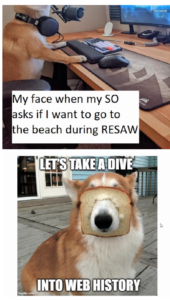
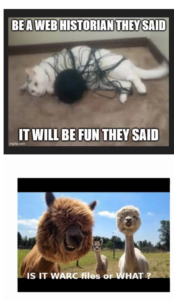
In addition, Kees Teszelszky, KB National Library of the Netherlands, presented the results of the WARCnet Twitter challenge launched at the beginning of the week, where the participants once again showed all their creativity.
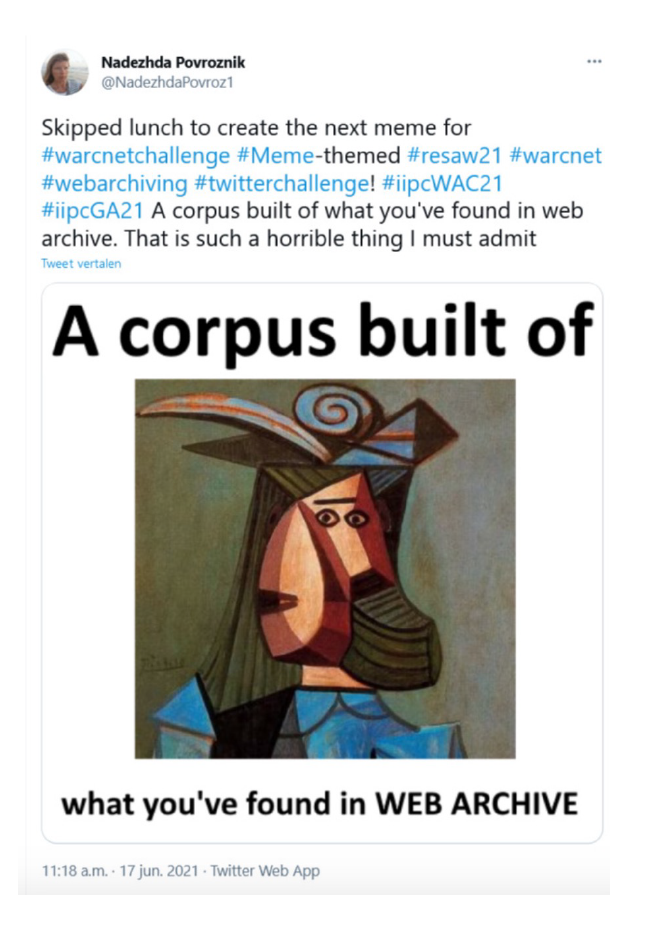
18 June: WARCNET project, collections and corpora, software heritage, and web archive challenges
The second day of the event started with a roundtable on the WARCnet project, chaired by Anne Helmond (University of Amsterdam). Some of its PIs and WG leaders members, Niels Brügger (Aarhus University), Sally Chambers (Ghent University), Michael Kurzmeier (Maynooth University), Valérie Schafer (University of Luxembourg) and Jane Winters (University of London) presented the origins of this transnational network of researchers and web archivists in 2019 and the tasks of the six different working groups: Comparing entire web domains, Transnational events, Digital methods and tools, (Trans)national research data management, The WARCnet Code Book of web archive data formats, and finally the Post-WARCnet.
Since it couldn’t be otherwise, the issue of the Covid-19 digital traces took the audience during the discussions on topic collections and corpora. Firstly, Friedel Geeraert (KBR) and Jane Winters (University of London) presented a case study from WARCNet on how the WG2 documented how European web archivists have collected the born-digital traces of COVID-19. They conducted the analysis of a series of interviews with web archivists and curators. Secondly, Tizian Zumthurm presented the results of the analysis of the contents of covidmemory.lu, giving an overview of the gap in Covid-19 memory banks and the representative and performative biases in crowdsourced archives.
During the last day of the conference, the audience had the pleasure to listen to the keynote by Roberto Di Cosmo (IRILL, Software Heritage) entitled “Software heritage: a common infrastructure to preserve our software commons” chaired by Anat Ben-David (Open University of Israel). Software source code is part of our cultural heritage, as explained by Roberto Di Cosmo. Unfortunately, there are software misplaced, lost, or behind barriers, mainly because they depend on code hosting sites that shut down when their popularity decreases. The good news is that most founders are still here and willing to share, making it urgent to collect their knowledge. That’s why the main objective of Software Heritage is to collect, preserve and share all open software source code. It is an open, non-profit initiative whose mission is to ensure that the scientific and technological knowledge embedded in software source code will be preserved in the long term and made available to all. He finalized his intervention with a call to action from individuals to companies, from public to private entities, to contribute actively to this mission (watch the keynote).
Parallel sessions related to “Youth” or “Events and web crawls” attracted many questions and discussions.

The last session of the day focused on web archives challenges and was chaired by Nicola Bingham (The British Library). In there, Emily Maemura presented an overview of infrastructural approaches in web archives research, followed by Pedro Gomes and his colleagues (FCCN). They explained how they integrated Geocities in Arquivo.pt and its use for national and international researchers. On the other hand, James Hodges (University of Texas) analysed the chains of interdependence in unreleased game assets and how they navigate from mainstream development to web-based margins. In addition, Ian Milligan (University of Waterloo) and Helge Holzmann (Internet Archive) presented their project based on integrating Archives Unleashed with the Internet Archive to create an end-to-end solution to collect and study web archives. To finalize, Jessica Ogden (University of Bristol) and her colleagues presented “Patterns of Use: Conceptualising the role of web archives in online discourse,” giving an overview of how web archives have been used in the past and how they are used now.
Stay tuned for the next RESAW conferences
In the closing remarks, Niels Brügger reminded what’s the aim of the RESAW Conferences: “to establish an international forum where researchers from all disciplines, web archives (curators, IT developers, etc.), artists, and others who are working with the archived web can get together to share ideas.” And with this primary goal in mind, he reminded the audience that the next RESAW Conference would be hosted in Aix-Marseille in 2023 and unveiled the one in 2025, which will occur at the University of Siegen, Germany. So see you in 2023 in Aix-Marseille!
Carmen Noguera, PhD student in the HIVI Project
